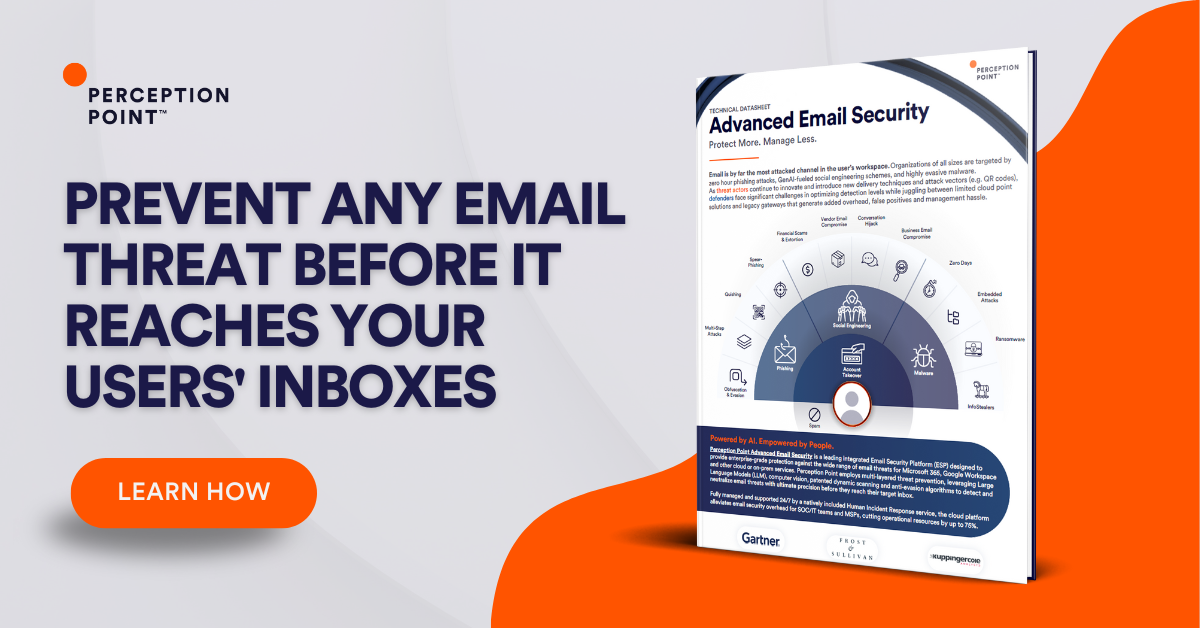What Is Email Security as a Service?
Email security as a service is a cloud-based solution aimed at protecting an organization’s email communications from cyber threats such as phishing, malware, and spam. Using advanced scanning algorithms and threat intelligence databases, email security as a service solutions detect and neutralize potential security breaches before they reach the end user’s inbox.
Email security as a service operates in the cloud, which makes it easier for organizations to deploy, and allows for continuous updates to security protocols without direct intervention from the IT department. By outsourcing email security to a cloud provider, organizations can benefit from high levels of expertise and economies of scale, offering better protection against evolving threats at a lower cost.
In this article
Cloud Email Security Solutions vs. On-Premises Solutions
Cloud email security solutions offer several advantages over traditional on-premises security systems:
- Scalability: As an organization grows, the volume of email traffic grows and email security solutions must scale accordingly. Cloud solutions can easily scale up to handle this increased traffic without requiring an investment in hardware or significant infrastructure changes.
- Ease of deployment: Cloud-based solutions can be quickly deployed and integrated into an existing email system, reducing downtime and minimizing the impact on productivity.
- Cost efficiency: Cloud email security solutions typically operate on a subscription model, which includes maintenance, updates, and support. This model eliminates the need for large upfront investments in hardware and software required by on-premises solutions, reducing the overall cost of ownership.
- Updated security measures: Security threats evolve rapidly, requiring frequent updates to defensive measures. Cloud-based solutions benefit from automatic and continuous updates, unlike on-premises solutions which require manual updates and can lag behind the latest security technology and threat intelligence.

Tal ZamirCTO, Perception Point
Tal Zamir is a 20-year software industry leader with a track record of solving urgent business challenges by reimagining how technology works.
TIPS FROM THE EXPERTS
- Enhance visibility with detailed threat hunting and forensic capabilities. Ensure that your email security provider offers advanced threat hunting and forensic capabilities, allowing your security team to perform in-depth investigations on email threats and understand the full scope of any incident. This enables you to improve response strategies and prevent recurrence.
- Run threat simulations on your email security system. Conduct regular simulations to uncover potential vulnerabilities and improve the robustness of your email defenses.
- Adopt sender behavior analysis using AI-driven anomaly detection. Move beyond simple behavioral analysis by deploying AI-driven anomaly detection to scrutinize the sender’s historical behavior. This helps in identifying subtle signs of compromised accounts or impersonation attempts.
Cloud Email Security Features
Static Signatures
Email security services rely on a database of signature definitions, which are unique identifiers for specific strains of malware. Email security systems scan incoming emails and their attachments for these signatures, enabling the immediate identification and blocking of known threats.
While static signature detection is highly effective against widespread, recognized malware, it is complemented by more dynamic methods to counter novel threats. The maintenance and regular updating of signature databases are critical to the effectiveness of static signature detection. Security providers continuously analyze new malware variants to add their signatures to the database, ensuring that protection measures remain current.
Contextual and Behavioral Analysis
Contextual and behavioral analysis in cloud email security leverages the power of artificial intelligence and machine learning to examine the context in which an email is sent. This includes the relationship between the sender and recipient, the typical content and style of communication, and the timing of the email. Behavioral analysis monitors for anomalies in user behavior, such as sudden changes in the frequency or type of emails sent.
By understanding the normal patterns of communication within an organization, these systems can identify deviations that suggest phishing, spear-phishing, or insider threats. This method is particularly effective against sophisticated attacks that do not contain overtly malicious content but are designed to manipulate the recipient in subtle ways.
Threat Intelligence
Threat intelligence involves the collection, analysis, and dissemination of information on threat actors, their methodologies, and the indicators of compromise. By integrating threat intelligence into email security solutions, organizations can preemptively block threats based on known malicious IP addresses, URLs, and file signatures.
Real-time threat intelligence feeds enable cloud email security systems to dynamically adapt to new threats. As threat landscapes evolve, these systems can update their defensive measures accordingly, ensuring that security postures are not static but evolve in tandem with the threat environment. This continuous updating mechanism is crucial for defending against zero-day vulnerabilities.
Content Filtering and Data Loss Prevention
Content filtering involves scanning incoming and outgoing emails for sensitive information, ensuring compliance with company policies and regulatory requirements. Filters can be customized to block emails containing specific types of data, like credit card numbers or confidential material, thus preventing accidental or intentional data leaks.
Data loss prevention (DLP) goes a step further by monitoring and controlling the transfer of sensitive information. DLP systems can enforce encryption, quarantine suspicious emails for review, and even block information transmission, ensuring that critical data remains secure within the organization.
Spam Filtering
Spam filtering is designed to separate unsolicited, bulk emails from legitimate communications. By employing a variety of detection algorithms, spam filters assess emails based on their source, content, and sending behavior. Techniques such as blacklisting known spam sources, content analysis to identify common spam characteristics, and reputation scoring to evaluate sender integrity help in minimizing the volume of spam reaching user inboxes.
Effective spam filtering not only improves productivity by reducing clutter but also acts as a first line of defense against phishing attempts and malware distribution. In addition to traditional filtering techniques, modern spam filters incorporate machine learning algorithms to adapt to new spam tactics. They analyze patterns and learn from user feedback, such as marking emails as spam or not spam, to continuously improve accuracy.
Anti-Phishing Engines
These engines utilize a mix of signature-based detection, machine learning, and heuristics to identify and block phishing attempts. By analyzing the structure, content, and sender information of incoming emails, anti-phishing technologies can distinguish between legitimate communications and potential phishing attacks. This includes the detection of spoofed email addresses, misleading links that mimic reputable sites, and the presence of social engineering cues designed to deceive recipients.
The integration of machine learning allows for the identification of new and evolving phishing techniques by learning from patterns in previously identified attacks. This capability ensures that even sophisticated, previously unseen phishing attempts can be detected and neutralized.
Anti Evasion
Evasion tactics in email-based attacks can include the use of polymorphic malware that changes its code to avoid signature detection, the obfuscation of malicious URLs or payloads within emails, and the employment of social engineering techniques to trick users into bypassing security protocols themselves. Anti-evasion strategies leverage deep inspection and analysis of both the content and behavior of emails to identify such tactics.
By employing a combination of static and dynamic analysis, anti-evasion mechanisms can uncover hidden malware in attachments and malicious links within the body of the email. Dynamic analysis, for example, involves executing suspicious code in a sandbox environment to observe its behavior without endangering the organization’s network.
Managed Incident Response
Managed incident response in cloud email security involves a team of security experts who take immediate action when a threat is detected. This team analyzes the threat, isolates affected systems, and eradicates the threat, minimizing the impact on the organization’s operations. They also provide post-incident reports and recommendations to prevent future breaches.
This service is particularly valuable as it offers organizations access to specialized skills and knowledge, ensuring a swift and effective response to incidents, which can significantly reduce the impact of email-based attacks on an organization.
Policy Management and Compliance Reporting
Policy management in cloud email security allows administrators to enforce specific rules regarding email usage and security. This includes setting up restrictions on the types of attachments that can be sent and received, as well as implementing guidelines for secure communication. These policies help organizations maintain high security standards and ensure consistent protection.
Compliance reporting provides detailed logs and reports on email traffic and security incidents. This assists organizations in proving compliance with regulations such as GDPR, PCI DSS, and HIPAA. It also offers insights into potential vulnerabilities, aiding in the improvement of security strategies.
Future Trends and Developments in Email Security as a Service
1. Threat Intelligence Sharing
Threat intelligence sharing allows organizations and security providers to exchange information about emerging threats in real-time. For example, when a new type of attack occurs against one organization, the attack pattern is immediately shared with all other organizations. This collaboration allows for a more dynamic response to cyber threats, enhancing the overall security posture of all participants.
By leveraging shared intelligence, email security as a service solutions can more effectively anticipate and mitigate sophisticated attacks, ensuring that defenses are constantly updated with the latest information. This collective effort allows defenders to stay ahead of attackers.
2. Zero-Trust Email Security
Zero-trust email security adopts a principle of “never trust, always verify,” challenging traditional security models that assume a level of trust within an organization’s network. It necessitates rigorous verification of all entities—both inside and outside the network—before granting access to email resources.
This model incorporates stringent access controls and multi-factor authentication (MFA), coupled with continuous monitoring of user behavior, to significantly lower the risk of data breaches and unauthorized access.
3. End-to-End Email Encryption
End-to-end encryption in email communications is gaining prominence as data privacy concerns escalate. By encrypting emails from sender to recipient, this method ensures that messages are inaccessible to anyone other than the intended parties, thereby providing a high level of security and privacy.
Businesses are increasingly integrating end-to-end encryption into their email security frameworks, recognizing its importance in protecting sensitive information and maintaining confidentiality. Encryption can also help comply with data protection regulations such as the CCPA and GDPR.
4. Natural Language Processing and Generative AI
Natural language processing (NLP) and generative AI models are transforming email security by providing advanced capabilities to understand and interpret communication patterns within an organization.
These technologies extend beyond traditional statistical approaches, offering a nuanced detection of social engineering attacks such as Business Email Compromise (BEC), impersonation, and phishing. Advanced email security tools can use generative AI to recognize AI-generated text patterns, and identify specialized attacks like email thread hijack.
5. Behavioral and Content-Based Analysis
Behavioral and content-based analysis techniques are critical in identifying and mitigating email security threats by focusing on the underlying behaviors and content that signify malicious intent. Anomaly detection capabilities examine changes in the sender’s tone, sentiment, and message content, using topic modeling to identify deviations that could indicate a security threat.
Content analysis, powered by LLM-based models, extracts sensitive information and performs entity recognition, enhancing the security framework’s ability to detect and respond to potential risks. Additionally, textual-obfuscation detection identifies attempts to evade security measures.
Related content: Read our guide to email security solutions
Email Security as a Service with Perception Point
Perception Point’s Advanced Email Security prevents Spam, Phishing, BEC, Malware, Account Takeover and Zero-Day exploits BEFORE they reach organizations using Microsoft 365, Google Workspace, or any cloud and on-prem email service.
Perception Point uniquely combines an advanced AI-powered threat prevention platform with a managed incident response service to protect the modern workspace. By fusing GenAI technology and human insight, Perception Point protects the productivity tools that matter the most to your business against any threat.
Patented AI-powered detection technology, scale-agnostic dynamic scanning, and multilayered architecture intercept all social engineering attempts, file & URL-based threats, malicious insiders, and data leaks. Perception Point’s platform is enhanced by cutting-edge LLM models to thwart known and emerging threats.
Reduce resource spend and time needed to secure your users’ email and workspace apps. Our all-included 24/7 Incident Response service, powered by autonomous AI and cybersecurity experts, manages our platform for you. No need to optimize detection, hunt for new threats, remediate incidents, or handle user requests. We do it for you — in record time.
Contact us to learn more about Perception Point’s Advanced Email Security.

Email security as a service is a cloud-based solution aimed at protecting an organization’s email communications from cyber threats such as phishing, malware, and spam. Using advanced scanning algorithms and threat intelligence databases, email security as a service solutions detect and neutralize potential security breaches before they reach the end user’s inbox.
– Static Signatures
– Contextual and Behavioral Analysis
– Threat Intelligence
– Content Filtering and Data Loss Prevention
– Spam Filtering
– Anti-Phishing Engines
– Anti Evasion
– Managed Incident Response
– Policy Management and Compliance Reporting
1. Threat Intelligence Sharing
2. Zero-Trust Email Security
3. End-to-End Email Encryption
4. Natural Language Processing and Generative AI
5. Behavioral and Content-Based Analysis
























